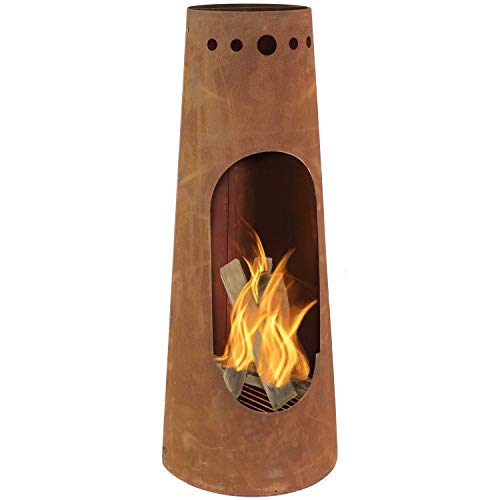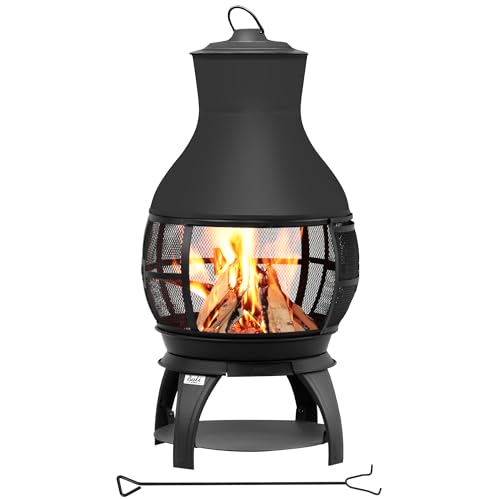How to Safely Maintain an Outdoor Chiminea
Outdoor chimineas add warmth and ambiance to your garden or patio. They are also a better choice for smaller spaces than traditional fireplaces.
Chimineas must be placed on a surface that is fireproof such as a patio made of bricks, concrete or stones. Chimineas should not be placed near eaves or any other overhead cover that might catch fire.
Types
Chimineas are a kind of outdoor firepit that has a chimney and a tall the hood that directs smoke upwards instead of out. Chimineas can be made from metal or clay and come in many different styles to fit in with any garden decor. Some chimineas are designed to allow cooking over the stove and can be used to prepare delicious home-cooked meals or enjoy snacks outdoors while chatting with family and friends.
A variety of wood types can be used in a Chiminea. Oak is a popular choice because it produces lots of heat and burns slowly, however other hardwoods may also be utilized in your chiminea. Apple is another option because it burns slow and releases a pleasant scent and is extremely versatile. Other choices include hickory, cedar, mesquite and pinon wood, which are aromatic and produce a pleasant smoke.
Metal chimineas may provide more design options than traditional terra-cotta varieties and are less susceptible to damage by rain. They are heavier and more prone to rust than clay models. Certain metal chimineas are coated with anti-rust paint that protects them from the weather. Cast iron chimineas offer a rustic appearance however they are the most heavy option.
It's important to prepare your chiminea prior lighting the fire. This involves a layer of gravel or sand at the bottom. This will prevent the ash from leaking out and damaging the base. Include a few pieces of wood as well as some kindling. When the paper begins burn, it triggers an air draft that will swiftly light the rest of the kindling and begin the fire in your chiminea.
While a chiminea is able to be positioned in the center of your garden, you should keep it far from any plants or structures. You should leave plenty of space around it in case it tips over or becomes too hot. Covering the chimney with metal mesh will prevent sparks and the ash from flying into flammable material.
Materials
If you opt for clay or
cast iron chiminea iron, your chiminea needs to be constructed from a sturdy material that can stand up to the heat. It is important to make sure that your chiminea fits your space, and is easy to store and move. It is also important to be aware of the amount of smoke the chiminea produces in order to cause trouble for neighbors.
The type of wood you choose to use in your chiminea is crucial and will determine the degree of heat it will get and how long it will last. Hardwoods such as cherry, apple and walnut are preferred by serious chimenea owners over softwoods. Hardwoods generate more heat and burn more efficiently than softwoods.
While some people may prefer the appearance of a traditional clay chiminea there are also contemporary and contemporary cast aluminum chimineas that have modern lines and geometric designs. These models are lighter and can be used with gas and wood stoves. They are a versatile option for outdoor spaces.
Both clay and cast iron Chimineas require a careful maintenance plan which includes cleaning and re-seasoning on occasion. Always place them on a solid foundation, such as terracotta tiles or concrete, or even leveled sand. It is also important to avoid water near your chiminea as it could damage the metal and cause cracks in clay or terracotta.
The initial seasoning process for Chiminesas is to light several small fires, allow them to cool, and then light another. This will increase the heat resistance and tolerance to heat of your chiminea. If you do not take this step, your chiminea might crack or break on its first use. It is recommended to protect your chiminea in the winter months or when it will not be used regularly because it protects it from the elements of snow and rain that can damage it. If you're worried about the safety and performance of your
chiminea near me then look into a model with an anti-spark device. This will prevent dangerous sparks.
Design
A chiminea can be an attractive and versatile outdoor fire feature. However, it is important to remember that just like any other fire pit made of wood, it must be maintained properly to prevent damage and ensure the safety of those who are enjoying the flames. By using protective covers and proper cleaning methods can make a significant difference in the life of your chiminea decorated.
chimineas for sale are available in a range of styles, materials and sizes to meet a range of aesthetic preferences as well as functional needs. Terracotta clay is a classic material that offers the classic Mexican look. Metal chimineas are less prone to damage and provide modern, sleek appearance.
It is also crucial to consider the location of your chiminea. The chiminea should be set in an open area to let air flow. This will maximize efficiency and create a cozy ambience around the
fire pits and chimineas. Additionally, placing it away from the patio cover and overhangs stops the buildup of smoke, which could damage the structures.
If your chiminea has a chimney, consider protecting it with a mesh screen to limit the number of sparks erupting through the air. To create a barrier, you can use the fence with a small hole bent slightly inward. You can also purchase a ceramic tile screen designed to catch sparks, and then lower them into the stack.
While it is tempting to use accelerants such as gasoline or lighter fluid to start a fire these chemicals could actually harm your chiminea by introducing too much heat too quickly. This could cause the walls to break or shatter resulting in injuries at worst and a ruined chiminea at the very best. In addition, accelerants could also cause your chiminea to explode, which is extremely hazardous for anyone who is near.
You can also season your chiminea with three or four small fires. This will help the chiminea to heal which will lead to less cracks and a lower risk of explosions. It is recommended not to burn anything but dried, well-seasoned hardwood in your chiminea.
Safety
Chimineas allow you to enjoy a fire outdoors with your family and friends. But, as with any outdoor flame they can be a risk to property and people. You can make sure that you and your family enjoy the warmth from your chiminea with no fear of fire or accident by following a few simple safety measures.
The first step to ensuring the safety of your
indoor chiminea is to ensure that it is placed on a non-flammable surface such as pavers, bricks or cement. This will prevent the chiminea from falling over and reducing the chances of it igniting anything in its vicinity.
Use only dry and seasoned wood for your Chiminea. Wet wood doesn't burn as well and can cause the chiminea's flames to go up or catch fire. A spark arrestor for a fireplace is also a must-have. It can be as easy as a piece of chicken wire bent around the top of the stack or as complicated as a specially chimney insert with a screen. Spark arrestors stop sparks from exploding into the neighbor's yard or onto flammable materials such as grass and bushes.
Lastly, be sure to keep your chiminea 30 feet away from any that could ignite, such as buildings, trees, sheds, clothes lines and awnings. This will help you to avoid an accident fire which could cause damage or even destruction to your home.

After you have installed your chiminea, and followed the steps outlined above, it's now time to take advantage of the radiant heat and warm flames! Be sure to build small fires, using only burning wood to get the flame moving, and then gradually adding larger wood to the fire. Keep a set of fireplace tools in your kit to add logs to the fire and then stoke it so that you don't have to touch it. Wearing long barbecue tools and gloves for fire is also an excellent idea when dealing with hot coals and the grate. This will enable you to manage the
chiminea near me in a safe manner and avoid burning your fingers.

 After you have installed your chiminea, and followed the steps outlined above, it's now time to take advantage of the radiant heat and warm flames! Be sure to build small fires, using only burning wood to get the flame moving, and then gradually adding larger wood to the fire. Keep a set of fireplace tools in your kit to add logs to the fire and then stoke it so that you don't have to touch it. Wearing long barbecue tools and gloves for fire is also an excellent idea when dealing with hot coals and the grate. This will enable you to manage the chiminea near me in a safe manner and avoid burning your fingers.
After you have installed your chiminea, and followed the steps outlined above, it's now time to take advantage of the radiant heat and warm flames! Be sure to build small fires, using only burning wood to get the flame moving, and then gradually adding larger wood to the fire. Keep a set of fireplace tools in your kit to add logs to the fire and then stoke it so that you don't have to touch it. Wearing long barbecue tools and gloves for fire is also an excellent idea when dealing with hot coals and the grate. This will enable you to manage the chiminea near me in a safe manner and avoid burning your fingers.